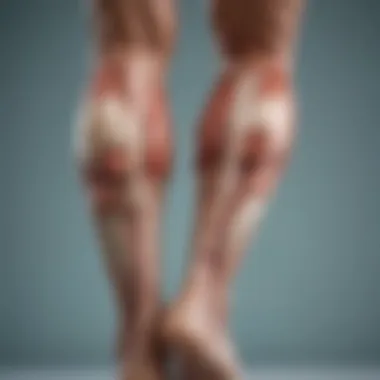Effective Strategies for Managing Calf Cramps


Intro
Calf cramps can be as unwelcome as a sudden downpour on an otherwise sunny beach day. For athletes, especially those who thrive in dynamic physical activities like surfing, experiencing a calf cramp is not just inconvenient; it can disrupt performance and diminish enjoyment in the sport. This article dives into identifying strategies that can help alleviate these spasms, enhancing both comfort during actions and overall efficacy in the water.
Understanding the nuances of calf cramps—from their physiological underpinnings to preventive measures and immediate remedies—can empower individuals with the knowledge they need. Everyone from the rookie paddler to the seasoned wave rider can benefit from grasping these vital insights. Let's embark on this expedition to demystify calf cramps and equip ourselves with tools for overcoming them.
Understanding Calf Cramps
Calf cramps can strike unexpectedly, leaving the affected person in discomfort and confusion. A seamless understanding of calf cramps is foundational for both active individuals and casual exercisers alike. By grasping the intricacies surrounding this condition, one gains the power to prevent, address, and eventually mitigate the debilitating effects of these sudden muscle contractions.
Recognizing the various types of cramps, their unique characteristics, and the symptoms that usually accompany them is key in formulating an effective relief strategy. Individuals ranging from surfers to weekend joggers will find that understanding calf cramps can directly impact their performance and enjoyment of activities that require lower leg endurance. Moreover, comprehending how hydration and nutrition play a critical role in prevention can lead to more conscious health choices.
Definition and Symptoms
Calf cramps are highly uncomfortable, often described as sudden, involuntary contractions of the calf muscles. They can occur during physical activities or even while at rest. The typical sensation experienced can range from a tight, pulling feeling in the muscle to intense pain that may cause a person to physically wince. Symptoms often include:
- A noticeable tightening in the calf muscle
- Pain that can be sharp or dull, persisting for several seconds to minutes
- Tenderness in the area following the spasm
Understanding these symptoms helps individuals identify calf cramps quickly and seek necessary intervention if needed.
Types of Muscle Cramps
Muscle cramps can be categorized into different types, each with unique triggers and characteristics that inform how best to respond to or prevent them.
Nocturnal Cramps
Nocturnal cramps, as the name suggests, usually happen at night while a person is sleeping. This can lead to disrupted sleep and residual soreness the next day. These cramps might be caused by factors like dehydration, muscle fatigue, or simply extended periods of immobility.
A key characteristic of nocturnal cramps is their sudden onset, often catching the individual completely off guard. For those seeking to manage calf cramps effectively, understanding why these episodes occur during the night is crucial. Stretching before bed and staying hydrated can influence the frequency and severity of these nocturnal muscle protests.
Exercise-Associated Cramps
Exercise-associated cramps often occur during physical activities, typically linked to intense exertion. This type of cramp particularly plagues athletes and active individuals, making it a significant focus in this article. The defining feature here is the occurrence of cramps during or shortly after strenuous events, particularly when combined with inadequate hydration or electrolyte imbalances.
The potential advantage of identifying exercise-associated cramps is the opportunity for proactive measures. Engaging in proper warm-up routines, maintaining hydration, and ensuring adequate nutrient intake can help stave off these cramps during workouts.
Heat Cramps
Heat cramps are a consequence of prolonged exposure to high temperatures and often occur during heavy sweating. They can hit anyone engaged in vigorous activity during a hot day, such as long-distance runners or surfers catching waves under the sun's glare. The key characteristic of heat cramps is their emergence in conjunction with dehydration and are frequently linked to insufficient salt intake during strenuous activity in hot conditions.
This type of cramp serves as an important signal from the body. The sudden intensification of muscle contraction under heat stress is an indicator that immediate action is required. Staying hydrated and replenishing electrolytes through sports drinks is beneficial for preventing heat cramps, making it a significant consideration for those keen on outdoor activities.
Causes of Calf Cramps
Understanding the causes of calf cramps lays the groundwork for effective prevention and treatment strategies. These cramps can strike when least expected, causing sharp pain that disrupts both activities and rest. By recognizing the root causes, individuals can take proactive steps to mitigate discomfort, thus enhancing their performance during physical activities, whether on the surfing board or during a morning jog. Causes of calf cramps can be broadly categorized into physiological factors and external triggers, each playing a pivotal role in understanding this ailment.
Physiological Factors
Dehydration
Dehydration is like a silent thief, robbing your muscles of the water they need to keep functioning effectively. When your body is low on fluids, it leads to a decrease in the elasticity and efficiency of muscle fibers, paving the way for cramps. The key characteristic of dehydration is its insidious development; you might not even realize it until you're feeling the cramps. For athletes, ensuring an adequate intake of water is critical, especially during long workout sessions or hot weather.
Moreover, dehydration can impact both performance and recovery. When muscles don't have enough hydration, they can become tense and more prone to cramping. An advantage of focusing on hydration in this article is that it is often easily corrected just by increasing fluid intake. However, on the flip side, some might find it difficult to gauge the right amount of water, especially if they are not accustomed to monitoring their intake.
Electrolyte Imbalance
Electrolyte imbalance is another culprit contributing to calf cramps. Electrolytes like sodium, potassium, and magnesium play a significant role in muscle function. An imbalance, whether due to heavy sweating, poor diet, or illness, can disrupt electrical impulses, leading to cramping. The unique feature of focusing on electrolyte balance is that it is not just about drinking fluids; it's also about consuming foods and supplements that replenish these critical minerals.
This is particularly beneficial in this article since many athletes may not realize the importance of maintaining a balanced electrolyte level. On the downside, relying too heavily on processed sports drinks can introduce excess sugar or other unwanted additives.
Muscle Fatigue
Last but not least, muscle fatigue warrants attention when discussing calf cramps. Pushing your muscles beyond their limits can dramatically increase cramping incidents. Fatigued muscles lose their ability to contract and relax efficiently, leading to painful spasms. The key characteristic here is that muscle fatigue often builds over time, making it easy to ignore until cramps set in.


The advantage of addressing muscle fatigue is multifaceted; it not only helps in preventing cramps but also enhances overall performance by promoting endurance. However, it demands a disciplined approach to physical training combined with adequate rest, a balance that can be tricky to maintain.
External Triggers
Temperature Extremes
Temperature extremes can wreak havoc on muscle function and may lead to cramps, especially in athletes who train in varying climates. Hot weather can dehydrate the body rapidly, while cold conditions can lead to muscle stiffness. A key characteristic of temperature extremes is that they often catch individuals off guard, especially when seasons change. Being mindful of these conditions is a beneficial point in this article, as it prompts attentive preparation for workouts.
One unique feature is that acclimatizing to temperature changes can significantly decrease the likelihood of cramps. However, it also means that athletes need to remain aware of their environment, which can add another layer of complexity to training routines.
Inadequate Warm-Up
Inadequate warm-up is often a quiet contributor to calf cramps that gets overlooked in the hustle of preparing for exercise. Jumping straight into intense activity without properly warming up can lead to muscle strain and cramping. The key characteristic of this trigger is its simplicity; a thorough warm-up primarily takes time, yet offers substantial benefits in flexibility and readiness.
Emphasizing warm-ups in this article provides readers with direct actions that can be taken to prevent cramps. However, for some, dedicating sufficient time to warm up might feel like an unnecessary burden on a busy schedule, which could be a disadvantage.
Overexertion
Overexertion cannot be ignored as a significant factor in calf cramps. Pushing oneself too hard during workouts, particularly after increasing intensity levels or duration, can lead to rapid muscle fatigue and cramps as a result. The key characteristic of overexertion is its gradual build-up; you might not feel the repercussions immediately, but they can strike unexpectedly.
Highlighting overexertion in this article is crucial as it emphasizes the importance of listening to one’s body. While the advantage of acknowledging this is that it can drastically reduce incident rates, the challenge lies in balancing aspiration and capability, something that often trips up many eager athletes.
Preventive Measures
Preventive measures hold great significance in avoiding calf cramps, especially for athletes and active individuals. Taking proactive steps can reduce the frequency and intensity of cramps, allowing one to engage freely in physical activities. These measures not only empower one to avoid unexpected discomfort but also enhance overall performance.
Hydration Practices
Staying hydrated is a cornerstone when tackling the threat of calf cramps. During exercise, the body loses fluids through sweat, which can lead to dehydration, when the muscle tissues lack the necessary moisture, increasing the chance of cramping. It’s important to drink water before, during, and after activity.
To check your hydration level, pay attention to the color of your urine. If it’s dark yellow or amber, chances are you need a swig of water. Likewise, try to keep drinking until your urine runs closer to a clear hue. This is an easy way to keep tabs on your hydration status.
Nutritional Considerations
Importance of Magnesium
Magnesium is a key player in muscle function and plays a role in preventing cramps. It helps muscles relax, which can be beneficial when one is feeling the tension that leads to cramping. An interesting aspect is its capacity to regulate electrolyte balance. Without enough magnesium, muscles may spasm from integral processes getting out of whack.
In the world of nutrition, magnesium is often considered a superstar. It exists in many foods, like spinach, almonds, and beans, and incorporating these into your diet could provide great benefits for muscle health. However, balancing magnesium intake is essential. Too much may lead to gastrointestinal issues. So, moderation is the name of the game.
Potassium-Rich Foods
Potassium is another critical nutrient for muscle health, playing a pivotal role in transmitting nerve signals that communicate muscle contractions. Consuming potassium-rich foods can help maintain muscle function and fend off cramps. Bananas are often touted for their potassium content, but don’t overlook other powerhouses like avocados, sweet potatoes, and tomatoes. They pack quite the punch!
Incorporating these foods into your diet isn't just beneficial; it’s also delicious. The unique feature of potassium-rich foods is that they are often versatile, lending themselves to a myriad of dishes and snacks. However, those with certain medical conditions, like kidney disease, may need to monitor their potassium intake closely.
Regular Stretching Routines
Engaging in a regular stretching routine before and after workouts is critical in keeping calf cramps at bay. Stretching increases blood flow to the muscles and can enhance flexibility, reducing the likelihood of sudden cramps.
Focus on calf stretches; lean against a wall with one foot back, keeping it straight while bending the other knee. Hold for about twenty seconds, switching sides afterward. Another great stretch is to sit on the ground, legs extended, and reach for your toes. Not only will stretching help prevent cramping, but it can also improve overall athletic performance.
"An ounce of prevention is worth a pound of cure."
In essence, adopting preventive measures is a smart strategy that can lead to improved well-being and athletic performance. Being mindful of hydration, nutrition, and the importance of stretching forms a solid foundation in the quest to dodge calf cramps.
Immediate Relief Techniques
In the face of sudden calf cramps, employing immediate relief techniques can be a real game changer. These methods not only offer swift alleviation but also empower individuals to regain control over their physical discomfort and maintain their activities. Understanding how stretching, applying heat, and cold compresses play an essential role in muscle recovery can drastically improve one's experience, especially for those engaged in regular physical activities like surfing or other high-impact sports.
Stretching the Affected Muscle
When a calf cramp strikes, one of the quickest solutions is to stretch the affected muscle. Engaging in a gentle yet firm stretch helps to ease the tightness and combat the spasm effectively. For instance, when feeling the onset of a cramp, leaning against a wall and keeping the affected leg back while pushing the heel down can stretch the gastrocnemius muscle.
This simple act promotes blood flow and assists in delivering oxygen to the muscle fibers. It is also crucial to remember that stretching should be gentle; aggressive stretching can further aggravate the muscle. Consistent practice of such stretches not only helps in immediate relief but can also prevent future cramps from occurring.


Applying Heat or Cold
Heat Therapy
Heat therapy carries a number of benefits for treating calf cramps. Applying heat can relax the tense muscles and improve circulation. This can be particularly useful when cramps are associated with stiffness, allowing the muscles to regain their flexibility.
One popular way to apply heat is to use a warm towel or heating pad placed on the calf for approximately 15-20 minutes. This method is favored by many due to its simplicity and effectiveness. However, it's essential to monitor the temperature to prevent skin damage.
- Key Characteristic: Heat works by increasing blood flow.
- Unique Feature: Unlike cold, which numbs the area, heat allows the muscles to relax fully.
- Advantages: Promotes relaxation and decreases stiffness, making it easier to resume activities.
Yet, those using heat therapy should remain cautious, as it can result in dehydration and also not be effective during acute injuries.
Cold Compresses
Cold compresses also have their special place in managing calf cramps. They provide instant relief by numbing the pain and reducing inflammation. Applying a cold pack to the area can be particularly useful right after a strenuous physical activity, where the risk of cramping is higher.
A simple method to apply cold is using a bag of ice wrapped in a cloth, which should be pressed against the muscle for around 15 minutes. This technique is beneficial as it addresses the immediate pain that comes with cramps.
- Key Characteristic: Cold compresses work by reducing blood flow to the area.
- Unique Feature: This helps to minimize the swelling as it draws fluid away from the muscle.
- Advantages: Excellent choice post-exercise or whenever there's muscle soreness.
However, caution is vital with cold compresses; prolonged use can cause tissue damage or frostbite, so make sure to take breaks between applications.
Immediate relief techniques are a lifeline for those who suffer from calf cramps. Knowing when to apply heat or cold, and how to stretch effectively can make all the difference in maintaining mobility and comfort during physical activities.
Long-Term Management Strategies
Addressing calf cramps isn't just about quick fixes; it’s about developing a sustainable plan to keep them at bay. Long-term management strategies help individuals minimize the frequency and severity of cramps, particularly beneficial for athletes and active individuals like surfers. Here, we’ll delve deeper into physical therapy options and alternative therapies that can play a crucial role in this ongoing journey.
Physical Therapy Options
Physical therapy can be a game-changer when it comes to managing calf cramps over the long haul. This approach focuses on strengthening and conditioning the muscles through tailored exercises. A physical therapist can evaluate one's unique needs, pinpointing weak spots and muscle imbalances that may contribute to cramping.
The benefits of physical therapy include:
- Targeted Strengthening: exercises can fortify the calf muscles, making them more resilient.
- Improved Flexibility: often, tight muscles can lead to cramps; therapy can help stretch those areas effectively.
- Expert Guidance: having a professional oversee one's movements ensures safety and proper technique.
Investing time in physical therapy can yield dividends for those involved in high-demand activities such as surfing, as it fosters not just muscle robustness but also overall body awareness.
Alternative Therapies
Acupuncture
Acupuncture is often hailed for its holistic approach to healing, offering a unique perspective on calf cramps. In acupuncture, fine needles are inserted at specific points on the body. For calf cramps, treatment usually targets the meridians associated with leg muscles to enhance blood flow and reduce tension.
One key characteristic of acupuncture is its focus on balance. By addressing systemic issues or energy blockages, it can prove beneficial in reducing the frequency of cramps. Moreover, it’s often regarded as a safe form of therapy when conducted by a certified practitioner.
However, while some individuals may experience quick relief, others might notice a gradual improvement over time. Individual experiences may vary, making it essential for patients to communicate with their acupuncturist about the expected outcomes.
Massage Techniques
Massage techniques offer another avenue for those seeking relief from calf cramps. This approach involves manipulating the muscles to enhance circulation and decrease tightness. A key characteristic of massage is its immediate physical effects—many find significant relief right after a session.
Types of massage beneficial for cramp management typically include:
- Deep Tissue Massage: targets deep muscle layers, alleviating tension that can trigger cramps.
- Swedish Massage: provides more general relaxation and improves circulation, which aids in recovery.
One unique feature of massage techniques is the array of methods available; from self-massage to professional sessions, there’s something for everyone. While professional massage can be costly, techniques like foam rolling can empower individuals to manage their muscle health by themselves, giving them the control to relieve tension and prevent muscle cramping.
Overall, integrating these alternative therapies into a long-term strategy can significantly enhance one’s ability to manage calf cramps, improving comfort and performance in physical activities.
Role of Exercise in Prevention
Physical activity plays a pivotal role in preventing calf cramps, especially for individuals who engage in regular exercise, such as surfers, athletes, and fitness enthusiasts. Exercise not only strengthens the muscles but also improves flexibility and endurance, all of which are key to minimizing the occurrence of painful muscle contractions. In this section, we will delve into how practical exercise strategies can serve as first-line defenses against calf cramps.
Importance of a Balanced Workout Routine


A balanced workout routine combines cardiovascular training, strength exercises, and flexibility work. This trifecta caters to the varied demands placed on the calf muscles during activities like surfing or running.
Key Benefits of a Balanced Routine:
- Muscle Endurance: Short, intense bursts can lead to muscle fatigue, making cramps more likely. By incorporating lower-intensity, longer-duration exercises, you can build endurance without overwhelming your muscles.
- Flexibility and Mobility: Stretching is crucial. It enhances muscle elasticity, reducing the chances of undue strain during high-impact activities. Simple calf stretches, such as the standing calf stretch, can be a game changer.
- Injury Prevention: Imbalance in muscle groups can lead to cramping. For instance, if your calf muscles are stronger than your hamstrings, this can lead to an increased likelihood of cramps. A balanced routine helps ensure no muscle group is overdeveloped compared to others.
"A balanced workout is not just about working harder, but also about working smarter. It lays the foundation to maintain muscle health and functionality."
Incorporating Strength Training
Incorporating strength training specifically targets the calf muscles, which can be beneficial in both form and function. Targeted exercises help in building the muscle fibers responsible for endurance and reduce the likelihood of cramps.
Effective Strengthening Exercises:
- Calf Raises: Stand on the edge of a step, allowing your heels to dip below the step level. Raise your body using your calf muscles, then lower back down for a full range of motion. This not only strengthens but also aids flexibility.
- Resistance Band Exercises: Use a resistance band to perform ankle flexion and extension. This activates the calf muscles in various ways and mimics the actions performed in many sports.
- Squats: Regular squats help balance out the leg muscles, ensuring equal strength across related muscle groups, which can alleviate undue pressure on the calves.
Specific Considerations for Surfers
Surfing is not just a sport; it’s a lifestyle, filled with exhilarating moments and breathtaking challenges. However, it carries particular demands on the body that can lead to calf cramps if not managed properly. Understanding the nuances of how surfing affects muscle conditions is crucial for surfers who aim to ride those waves without unwanted interruptions.
Impact of Surfing on Muscle Cramps
The act of surfing requires a unique combination of strength, endurance, and flexibility. When surfers paddle to catch a wave, they engage their calf muscles substantially. If these muscles are overworked without adequate preparation, cramps may strike unexpectedly. Factors like cold water temperatures and prolonged periods of inactivity while waiting for the perfect wave can exacerbate this issue. Additionally, inconsistent or sudden physical exertion while surfing can lead to muscle fatigue, contributing to the occurrence of cramps.
"Surfers need to find a balance between their excitement for the waves and the care of their bodies, especially the calves, to avoid those sharp, biting cramps that can take you by surprise."
Unique Stretching Techniques for Surfers
To combat the risk of calf cramps, surfers should consider specific stretching techniques that cater to their individual needs. Incorporating these stretches into a daily routine can aid in warm-ups, cooldowns, and recovery periods. Some effective techniques include:
- Calf Raises: Stand on the edge of a step and raise up onto your toes, then lower your heels below the step level. This strengthens and stretches the calves simultaneously.
- Wall Stretch: Position your hands on a wall at shoulder height. Step back with one leg, keeping it straight and your foot flat on the ground. Bend the front knee to feel a stretch in the calf of the back leg.
- Seated Forward Bend: Sit with your legs extended and slowly bend forward, reaching for your toes. This helps with overall leg flexibility and relaxation.
Regular practice of these stretches not only promotes flexibility but also enhances overall muscle recovery after intense surf sessions.
By taking these specific considerations into account, surfers can significantly reduce their chances of experiencing calf cramps, allowing them to focus on what's important: enjoying the ride.
When to Consult a Professional
Understanding when to seek professional help for calf cramps is essential, especially for those who engage in physical activities like surfing or running. While many calf cramps can be managed with home remedies and preventive strategies, there are certain situations where it’s prudent to consult a healthcare provider.
Identifying these circumstances not only aids in effective treatment but also helps in preventing possible complications. Knowing the right moment to seek assistance can be the difference between a simple cramp disrupting your plans and a serious underlying condition being addressed before it escalates.
Recognizing Severe Symptoms
It’s crucial to pay attention to your body’s signals. Here are some severe symptoms that can indicate the need for professional consultation:
- Persistent Pain: If the cramp does not let up after a few minutes and continues to cause agony, it might be more than a simple cramp. Soreness that lingers can suggest a muscle strain or other injuries.
- Swelling or Redness: Unusual swelling, warmth, or redness in the area could point to deeper issues like a vascular problem or an infection. Ignoring these symptoms can lead to adverse health effects.
- Muscle Weakness: If you notice a decrease in strength or functionality in your calf, this should raise red flags. Muscle weakness accompanying cramps could indicate nerve damage or more serious complications.
- Numbness or Tingling: Experiencing numbness, tingling, or a loss of sensation in the leg could suggest nerve compression or other neurological issues. It’s important to address this with a healthcare professional promptly.
"When cramping escalates to the point of affecting daily activities or involves severe symptoms, do not hesitate to reach out for help."
Choosing Appropriate Healthcare Providers
Selecting the right healthcare professional is pivotal for proper diagnosis and treatment. Depending on your specific symptoms and their severity, consider these options:
- Primary Care Physician: Your first line of defense. They can conduct a preliminary assessment, rule out common causes, and recommend further action.
- Physiotherapist: If cramps are frequent or tied to your exercise routine, a physiotherapist can offer tailored exercises and stretches to mitigate issues.
- Sports Medicine Specialist: These practitioners specialize in physical activities. They can diagnose any sports-related injuries and provide targeted treatment plans that fit your lifestyle.
- Neurologist or Rheumatologist: For cases where nerve issues or inflammatory conditions are suspected, these specialists can offer advanced diagnostics and therapies.
In the realm of calf cramps, awareness is the first step toward effective management and recovery.
Concluding Thoughts
Summary of Key Points:
- Awareness of Triggers: It's vital to identify what might trigger calf cramps in your routine—be it dehydration, electrolyte imbalance, or simply just overdoing it.
- Preventive Measures: Regular hydration practices, balanced nutrition focusing on magnesium and potassium, and consistent stretching can be your best allies in prevention.
- Immediate Relief: Knowing how to handle an oncoming cramp with stretching, heating, or cooling can greatly reduce discomfort.
By keeping these points in mind, individuals can foster a proactive approach instead of a reactive one.
"An ounce of prevention is worth a pound of cure."
Encouragement for Ongoing Self-Care:
Incorporating self-care routines into daily life goes beyond just addressing cramps when they appear. Regular stretching, staying hydrated, and nourishing the body with essential nutrients should become second nature. It is like tuning an instrument; little adjustments here and there can lead to a much smoother performance overall. Also, take the time to listen to your body—it's your best guide. After all, understanding our physical self often leads to a better overall experience in pursuits we love, whether that’s catching waves or conquering daily commutes.
Self-care isn’t just a luxury; it’s a necessity. Embracing a lifestyle that prioritizes muscle care can help keep those pesky cramps at bay, allowing you to enjoy activities with less disruption. Ultimately, it's about fostering a balance that supports both performance and enjoyment.













